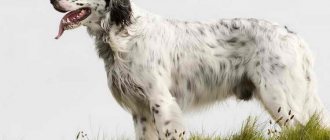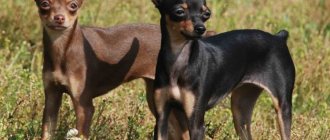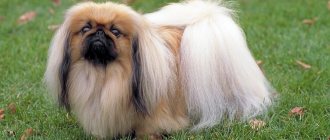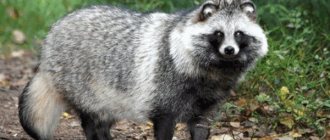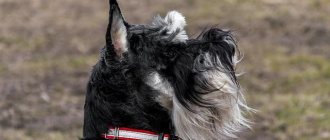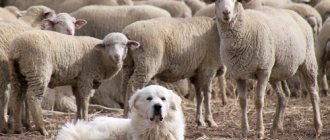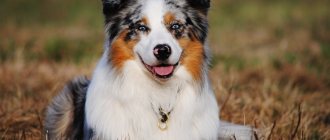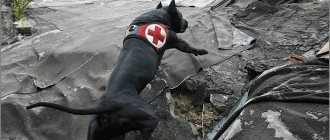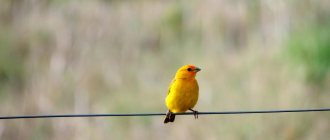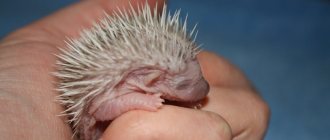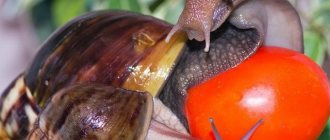Main characteristics
| Breed parameters | |
| Country of origin: | Germany |
| Weight of the breed: | males: 23-35 kg, females: 20-27 kg |
| Height at withers: | males: 62-66 cm, females: 58-63 cm |
| Temperament: | active |
| Wool: | short |
| Role in human life: | companion, hunting |
The German Shorthaired Pointer is an excellent watchman, hunter, and companion. They are very loyal and dependent on their person, needing attention and interaction.
Nutrition of the German shorthaired pointer
The diet of a hunting dog is slightly different from that of other breeds. The basis of a German cop's diet should be meat cut into small pieces, to which boiled cereals, except pearl barley, are added. It is necessary to feed the breed with vegetables and fruits, as well as add vitamin and mineral supplements to its food.
For adult dogs, two meals a day are recommended. Up to three months, puppies are fed 5 times a day, and already at six months of age - 3 times a day.
The little shorthaired pointer, which no longer receives mother's milk, requires dairy products in the form of kefir, milk and low-fat cottage cheese. In addition, his diet may include:
- cheese;
- raw yolk;
- boiled and shredded beef without fat or chicken.
From the age of six months, the puppy is no longer given milk, but cottage cheese and kefir are left in the diet.
The following natural products should not be fed to the German shorthaired pointer:
- tubular bones;
- potatoes;
- sweets;
- bakery products;
- salty, fatty, smoked and spicy foods that spoil the hunter’s sense of smell.
If the dog's diet consists of dry food, then it is recommended to choose high-quality premium or super premium food , specially designed for active dogs. Since the body has different needs at different periods of life, food is selected according to the age of the pet.
The dog should be fed strictly according to the instructions written on the food packaging. It is not recommended to increase the norm on your own, since overfeeding can lead to various diseases and obesity . Until the age of three months, puppies are fed granules soaked in kefir or water. From five months onwards, puppy food with hard granules is purchased for shorthaired pointers, the chewing of which helps the pet’s teeth change.
High-quality dry food already contains all the nutrients your dog needs, so there is no need to provide any additional foods or additives.
Origin story
The name Kurzhaar appeared as a result of the merger of two German words “kurz” and “haar”, which means short hair. Americans call these dogs German Shorthaired Pointer, and Russians call them German Shorthaired Pointers.
The first individuals appeared in the 17th century in Germany. At that time they had a slightly different appearance and were significantly different from their contemporaries. Closer to the 19th century, they gradually acquired the shape that we are accustomed to seeing in our time.
The ancestors of the modern shorthaired pointer are Spanish and English pointers, which crossed with each other to strengthen their hunting skills. They were able to work both on land and on water. Their innate tendency to approach silently and carefully, without spooking their prey, was highly valued. However, with the advent of firearms, this feature lost its significance.
The first representative of the shorthaired pointer was brought to America in 25 by Dr. C. Thornton. The doctor was actively involved in their development and a few years later they were recognized and registered by the American Kennel Club.
The Second World War somewhat intervened in the rapid development of the breed and made its own adjustments, especially in Germany. The best representatives were sent to Yugoslavia, many were hidden by the breeders as especially valuable property. After the end of hostilities, local breeders were left out of work, as they did not have access to the best samples. They started the revival from scratch and collected valuable blood bit by bit.
Meanwhile, American breeders continued to cultivate the breed and achieved amazing results. Pointer breeding reached its peak in the 50s. Magnificent examples of the breed actively took part in various competitions and exhibitions taking place at that time in America.
The excellent physical characteristics, exterior and hunting abilities of shorthaired pointers have inspired many American writers to write world masterpieces. One of these is a novel called “The Boston Detective” by R. Parker, in which the shorthaired pointer was one of the main protagonists. No less famous was “The True Story” by R. Bass, the main character of which was the same shorthaired pointer.
Today, the German Pointer ranks 19th in the ranking of the most popular breeds in the United States among 155 registered. This indicates popularity and demand among the local population. Kurts quickly gained the respect of hunters around the world. Today, this is one of the most revered dogs, it is loved and respected in Europe.
History of the breed
People have used dogs for hunting since ancient times. It is believed that the ancestors of the German Shorthaired Pointer (most likely they were Pachones - ancient Iberian dogs) came first to Spain, France, Italy and Belgium, and then to Germany from Mediterranean countries, where they were used for hunting game birds.
The Germans added aboriginal blood to the imported dogs by crossing them with Hanoverian hounds. In addition, Spanish dogs of the Perdigero Burgos breed, also brought to Germany, played an important role in the development of the future Pointer.
As a result of the mixing of these three breeds, the Old German Württenberg Pointer was eventually formed.
In the middle of the 18th century, when they began to kill game with guns, people came up with the idea that it would be very convenient to use a dog to scare the bird “under the gun.”
The German cops coped with the task in the best possible way. However, to give the Old German breed greater elegance, they began to mix Pointer blood into it, as a result, by the second half of the 19th century, the first shorthaired pointers appeared.
The genealogical (in modern language - breeding) book of the breed was opened in 1872. The standard was written from a dog named Hector. He had a spotted color based on white, and his height at the withers was no less than 67 cm.
The new breed almost immediately gained enormous popularity in Europe, and already in 1879 a single breed standard appeared (at the international level, however, it was established only in 1912).
German Pointers are so beloved by Americans that since the beginning of the 20th century, the United States can be considered their second home. The first shorthaired pointer was brought to America from Austria by a certain Charles Thorton in 1925, and thirty years later the number of dogs of this breed in the States exceeded fifteen thousand!
Did you know? The shorthaired pointer perfectly combines the hunting traits of a pointer and a spaniel. These dogs are equally good at bringing game both from land and from water; they can “work” on both feathered and four-legged game, even large ones. At the same time, they are excellent watchdogs, which cannot be said about either pointers or setters. They also do not have the unpleasant “dog” smell at all (except perhaps immediately after bathing, until the fur is dry).
In the Soviet Union, until the end of the Second World War, practically nothing was known about shorthaired pointers, and when these animals came to the Land of the Soviets, in their breeding, due to the ignorance of experts and breeders, so many mistakes began to be made that so-called “improved” variations began to appear breeds that, in fact, absolutely do not correspond to the international standard either in appearance or in temperament.
Only in the 70s of the last century did domestic dog handlers “come to their senses,” although to this day many domestic pointers are not such from a generally accepted European point of view and are not at all suitable for breeding work.
Photo of shorthaired pointer
Description and general characteristics
The shorthaired pointer is a hunting breed bred in Germany. This is an excellent athlete and companion. The pointer is designed for bird hunting, however, if desired, it can be taken as a companion for larger game, for example, deer.
Despite the natural instinct of a hunter, the shorthaired pointer is quite friendly and affectionate. He will always keep you company during walks and will gladly compete with you during an evening jog. The dog is endowed with a sharp mind, intelligence and efficiency. These animals are highly trainable.
Description of the shorthaired pointer breed
The name comes from two German words: “kurz” - short, “das Haar” - hair, wool. These are harmoniously developed medium-sized dogs with short hair, powerful, agile and hardy. Many years of selection work have made it possible to bring the dogs’ exterior to anatomical perfection. A prerequisite for belonging to the breed is a good balanced character. In the gaze of the kurtshaars one can read intelligence and intelligence.
Breed standard
For a representative of this breed, it is not enough to meet the standard for it to be allowed for breeding. Before coming to the exhibition, the Kurtz must pass the standards and confirm his working qualities.
The dog is endowed with an elegant body structure, but not like a greyhound, muscular, and physically developed. She should not be too thin, but overload is also unacceptable. Males reach a height of 66 cm, females are slightly smaller - 63 cm, with a weight of 20-35 kg. The chest is deep, the back is almost straight, strong long limbs are set straight, the tail is docked, and the neck is long. The head is dry, the skull is medium, the muzzle is wide and long, powerful jaws. The ears are set high, wide at the base, drooping, and fit tightly to the head. The eyes are expressive, round, medium in size, dark brown in color. Tightly fitting skin, without dewlap.
The coat is short, close-lying, hard and rough, without undercoat.
The standard describes a large number of points indicating deficiencies, plus disqualifying characteristics. It also says a lot about health and working qualities, since all this is inherited by offspring.
Colors:
- Solid brown.
- Brown with specks, white markings are allowed on the paws and chest area.
- Dark roan (even distribution of white and dark brown hairs) with a completely brown head and markings, as well as white markings.
- Light roan (predominance of brown-white hairs over light brown) with a completely brown head, without spots or specks.
- Black base with markings like light and dark roan and brown solid.
- White with specks or spots, with brown markings on the head.
What can the breed be taught?
German Pointer —
universal service dog
. Its training consists of two stages: first, the puppy is accustomed to certain commands (this can be done at home), and then trained, already in the field.
It is in the process of coaching that the acquired skills are consolidated and the instincts inherent in nature are revealed.
Important! When purchasing a dog “for work”, think about choosing a nickname in advance.
The louder and shorter it is, the easier it will be for you to call your pet, and for him to perceive your call. The names of purebred dogs are often long and complex, which is due to certain rules for their formation. But for everyday use, it is better to choose a shortened and easy to pronounce version, for example, Benjamin - Ben, Diana - Dana or Dee, etc.
It is also important to understand that, regardless of whether you are going to hunt with your pet or walk with him “ to serve”, the dog must master certain universal rules of behavior in any case.
In particular, the animal must respond to calls, clearly understand prohibitions, not pester strangers and especially not show aggression towards them, not bark in situations where, from your point of view, this is inappropriate, etc. Such a training course, in principle, can be organized for your pet yourself, showing patience and consistency.
Important! The dog must master the basic bookmarks during the first year of life. At a more mature age, the “material that has been covered” is mainly consolidated.
Vocational training
is
a slightly different task.
It is best to contact a professional trainer for this purpose. With the right approach, a German pointer should be a full-fledged hunter by the age of two, and a real pro by the age of three
.
In particular, a hunting dog must be able to:
- do not react to external stimuli, remaining in place no matter what;
- stay close to the owner regardless of the presence or absence of a leash;
- quickly and clearly carry out the commands: “come to me”, “forward”, “lie down” and “sit”, and the last two -
as much as the owner needs; - upon a prohibiting command, immediately stop the unlawful behavior;
- understand not only the voice, but also the gestures of the owner (when hunting, sometimes this is simply necessary).
There are certain rules and methods for training hunting dogs, shorthaired pointer. —
The student is smart and diligent, so it all depends on the teacher!
Character and temperament
The German pointer is very emotional and energetic, she loves long walks, nature, and active games. If the future owner does not have the opportunity to provide her with all this, then it is probably worth looking for someone else. Since a melancholic and measured way of life is completely unsuitable for the Pointer. Without activity, he suffers and this will negatively affect the environment, because the accumulated energy needs to be put somewhere.
Shorthaired Pointers are endowed with an ideal sense of smell, swim well, and love to spend time in the water. Since the breed is active, it is suitable for families with children, people who prefer active recreation, athletes, and hunters. They are absolutely not suitable for homebodies and those who do not lead an active lifestyle, since the dog requires a lot of attention and time.
In addition to an active lifestyle, Shorthaired Pointers constantly need to be given food for thought. These can be interesting and unusual training activities, complex training, intellectual games, communication with other dogs and socialization. Regarding socialization, it needs to start as early as possible, literally from the first appearance.
Maintenance and care
When keeping a shorthaired pointer in your home, you should pay attention to some points:
- Feeding the Shorthaired Pointer should be complete and properly balanced, no matter whether you feed the dog with specialized dog food or natural food.
- The shorthaired pointer, like any pointer, should not be overfed; carefully monitor the dog’s weight, try to maintain it within the breed norm: for a male 25-32 kg, for a female 20-27 kg.
- The Shorthaired Pointer is a short-haired breed of dog that has a pronounced seasonal shedding. It is important to properly care for the shorthaired pointer's coat. Two or three times a week, the Shorthaired Pointer should be combed with a special brush or massage mitten. During the shedding period, comb your dog every day, this will rid you of hair in the apartment.
- The Shorthaired Pointer should be bathed no more than once a month. Bathing too often will cause your dog's coat to lose its natural shine due to the loss of the fatty coating that protects the dog's coat from dirt. When bathing a shorthaired pointer, it is advisable to use unscented shampoo so that the dog does not lose its hunting sense.
- The shorthaired pointer's floppy ears require constant attention from the dog owner. They should always be dry and clean. Dirt from the ears is removed with a cotton swab or damp cotton pad. If you see that your shorthaired pointer is scratching its ears a lot, contact your veterinarian; your dog may have ear mites.
- Keep an eye on the shorthaired pointer's eyes; they should be shiny and clean. To care for your eyes, you can wipe them with a cotton pad soaked in weak tea. If the shorthaired pointer's eyes are very watery or festered, the dog should be taken to the vet immediately.
- In the summer, the shorthaired pointer's claws grind down on the asphalt on long walks; in winter, you may have to trim the claws with a nail clipper once a month.
- It is better to keep the shorthaired pointer in a warm apartment; if you are going to keep the dog outside, in an enclosure, he will definitely need a heated kennel.
- The shorthaired pointer needs long, serious walks; just a walk in the yard will not work. He needs serious physical activity, without it everything will result in the destruction of the apartment, aggression and stress from boredom. The shorthaired pointer is created for hunting; if the owner cannot hunt with him, then he needs to find some kind of alternative that replaces hunting.
- When walking in the city, the shorthaired pointer must be on a leash. There are too many dangers in the city; if a shorthaired pointer decides to chase a cat, it will be very difficult to stop him.
- When walking your dog in winter or in heavy rain, it is advisable to wear a dog overall or blanket. The shorthaired pointer's coat does not retain heat well. While moving, the shorthaired pointer does not freeze for a long time, but as soon as it starts to walk or stops, it can quickly become hypothermic.
- The German pointer needs her own personal place, where the dog should feel like a master. When the dog is in its place, no one should disturb or disturb it.
Education and training
Raising a chicken starts from puppyhood. As soon as he crosses the threshold of your home, you need to immediately designate his place, introduce him to the environment and household members. On the first walk, you need to pay special attention to the area and show the place for walking. Early socialization will help prevent behavioral problems in the future and help you adapt to a new environment more quickly.
Training a shorthaired pointer is a real pleasure. Thanks to his high intelligence, excessive activity and passion for work, he can be taught almost anything. Quite often, Kurds successfully complete not only the basic course, but also a more complex version of training.
However, during the learning process, owners of these hunters need to be patient and have a positive attitude. Kurzhaar loves to learn and is ready to do this throughout his life; this is inherent in him at the genetic level. Even an adult pet can easily be taught new commands.
As you grow older, you should pay special attention to behavior correction. Kurki are quite distractible by nature and like to get lost, so it is important to focus on developing obedience. Your pet should hear you in any situation, even if the smells cloud your mind. The main emphasis should be on refusal commands, this will help you stop the dog and bring him to his senses.
Under no circumstances should you shout or punish your pet during training. Anger and beatings must be completely excluded. For serious offenses during training, it is enough not to give a treat and the dog will understand that he did something wrong. You can also slightly change the intonation in your voice, thus indicating errors.
Conditions for shorthaired pointer
The ideal conditions for a German Pointer are, of course, a country house. For all its versatility, initially the dog is still a hunter, and the opportunity to run freely in the open air, communicating with numerous living creatures - domestic and wild, is extremely necessary for such an animal.
Important! Shorthaired Pointers are exceptionally jumpy, therefore, when keeping such dogs in a country house with the possibility of free walking in the yard, you should take care of a fairly high fence: a low fence is not a hindrance for such an animal, it can easily be overcome if your pet takes it into his head to chase some kind of animal. either a bird or other random prey.
However, shorthaired dogs can also be kept in a city apartment if the owner is willing to devote enough time to his pet, provide him with a full-fledged walk and a field for hyperactivity.
For all their unpretentiousness, pointers are quite large animals and at the same time not herbivores.
In order to feed such an animal (this means not just not letting it die of hunger, but providing balanced and nutritious nutrition), a certain level of financial wealth is required. It is worth thinking about this before, buying into the relatively low cost of puppies, and bringing such an inhabitant into your home.
Hunting with shorthaired pointer
Watching the kurtz work is a real pleasure. Sensing game, the dog silently sneaks through the thicket in its direction. He is practically invisible, he stretches out like a string. Before the decisive jump, he freezes in his stance, he never flinches a single muscle, he does not make a sound, he is completely absorbed in his goal. Only after the shot and the received command does the dog take off and rush towards the prey. Nothing will stand in his way, not even dense, impenetrable thickets. If necessary, he will throw himself into the water, pass through the thorns and overcome the thicket. Nothing will stop the dog from bringing prey to its owner.
In recent years, shorthaired pointers are often used in hunting small wild animals (rabbits, foxes) and are even taken for wild boars. For your four-legged friend to become a real hunter, long months of training are needed. You need to go out into the area with him, teach him not to be afraid of shots and bring back prey. It is worth noting that German cops are very smart and learn quickly, they don’t need to repeat everything twice, they pick it up on the fly.
Multidisciplinary dogs of this breed are most often purchased in Germany and Austria, that is, directly in their homeland. You can also buy a worthy representative from us, but you will have to run around the fields for a long time to evaluate the working qualities of the parents.
With a good genetic makeup, shorthaired pointers learn to work with virtually no training. The hunter's instinct is in the blood.
Kurzhaar - reviews
- + Leave a review
Leave a review Reset
Galina.
https://irecommend.ru/content/kurtskhaar-0
Hello! This is our first dog. Sherlise. We adopted her when she was 3 months old. Now she is 9 months old. There were no special problems while keeping her. Very easy to train. Not picky about food. Easy to care for, there is practically no smell from the skin. Smart. Gets along well with children. Very very patient. If the child is very small, then at first it is better to monitor the communication between the dog and the child. To build the correct behavior of the dog Stop aggression. The child is 2.8, so he crawls on her, walks, pulls everything he can, but she doesn’t do anything... Even though we keep an eye on him, he still manages to torment her. Because of the size of an adult puppy, games of catch are better cancel. May drop the child :) There are some nuances. There may be minor problems with toilet training. If the parents are kept in an enclosure, then puppies from such parents are difficult to learn to be patient. But in an apartment this is important. Therefore, you will have to walk such a dog more often. Approximately every 2-2.5 hours. From 4 months onwards, the time can be increased. Another drawback of shorthaired pointers is that they like to pick up all kinds of crap on the street. This must be monitored and immediately weaned off. They will not stop picking up at all, so we teach the command “drop” " The dogs are very active. They need to be walked for at least 3 hours a day. They love to run, jump, and play. Therefore, it will be good if there is somewhere to run. They are very sociable with other dogs. Because of their love for everyone, they are not suitable as a watchdog. Can frighten unless we bark. The voice is very loud :) but they rarely bark. I recommend it as a friend and a hunter. They are excellent hunters. Each one baits differently. We only went hunting 4 times. He studies well, but for now he mostly talks and plays. I wish everyone good luck in raising your pets!
FRider
https://irecommend.ru/content/takuyu-sobaku-eshche-nado-poiskat
I've never had a dog before! My wife and daughter decided to convince me that having a dog would be funny, fun, interesting) Considering that my wife used to have a dog of the Shorthaired Pointer breed, she loved it very much and the decision was made to get this particular breed. Then I had no idea that the dog would be completely on me...
We found an advertisement for the sale of puppies and arranged a meeting with the breeder. The puppy was brought to us from another city. When I took it in my hands, he immediately began to lick me. It was touching, but then I had no idea what would happen next.
On the first day, I left for work, and my wife and daughter stayed to babysit him. Towards evening, I receive this message from my wife: “Let’s get him back.” The puppy was not yet accustomed to the new home and was whining every 5-10 minutes. Seriously! This lasted for several days. Of course I said no. We will not return!
The puppy grew, but still often went to the toilet in the apartment. Of course, this had a negative impact on our psyche.
One day, when we were not at home, he snuck into the child’s room and chewed up a lot of toys. The damage was severe, both financially and mentally. My daughter “lost” her favorite doll.
It is difficult to describe what we experienced then.
Time passed, I decided to raise a very active puppy. We signed up for OKD courses and started taking them to exhibitions.
Now he is already 3 years old and sometimes he can still go to the toilet at home, but this is very rare.
Then we made the mistake of taking a puppy. And not because he was crap or a hooligan, but because dogs of this breed should live with a hunter. But in our family there are no such people.
No matter how sad this story may sound. We still love our dog, we pet him (in a good way) and play.
By the way, a lot of fur flies off of it) You need to vacuum it every day!
Mentally
https://irecommend.ru/content/vospominaniya-o-kurtskhaare
In April, at the age of 11, our beloved and devoted friend, a shorthaired pointer named Kora (emphasis on O), left us. But let’s not talk about sad things, I’ll go straight to the description of the breed and character of our favorite.
Reading reviews from owners on this site, I got the feeling that we were talking about different dogs. Why is that? Let me start with the fact that ours had a very difficult character, I would say complex. In childhood, when I was a puppy and until about 3 years old, when I was left alone in the apartment, I constantly spoiled and chewed things (it’s no joke, throwing out 18 pairs of shoes, we remembered this number for the rest of our lives). The dog was raised and punished, but apparently this was how she expressed her dissatisfaction with loneliness, and over time she outgrew it.
It is worth noting that the dog established a clear hierarchy for itself in the family and adhered to it until the end of its life. The most important people she obeyed unquestioningly were her grandfather and grandmother; Mom and Dad were at her level, she obeyed, but could show her teeth and growl when she was punished. I, since I myself was a child of 9 years old when Cora came to us, I think, was in the role of a younger sister, whom she did not value at all). She started listening to me when I was 18 years old.
Our shorthaired pointer was also completely unresponsive to strangers in the house or on our summer cottage. The intercom rang, the door rang, someone walked past the fence at the dacha - the dog immediately started barking, showing how she was defending the territory. If a stranger was in the house, the dog could bark (but never rush or bite), and always watched him, what he was doing and where he was going. So, for example, Cora spent more than 3 years getting used to my boyfriend, although he was at home almost every day. And only a year and a half before her death, she began to approach him to stroke him, stand with her front paws on his shoulders and show her affection in other ways.
So ours had very clearly expressed security skills, and not hunting ones.
They never took him hunting because the dog was very afraid of thunderstorms, thunder, loud shots and bangs. At the age of 10, during a thunderstorm, she even had a seizure, when she fell to the floor and began to thrash in a fit.
At the same time, the shorthaired pointer is a very loyal dog, as others have written. She really didn’t like it when the family left and she was given to her grandfather at home; she could refuse food. When we came home, even if we were away for less than 10 minutes, the dog was happy as if many hours had passed.
Still, I think that the features that I described were simply characteristic of her due to her individual character. Every dog is different, even if the breed is the same.
Love your pets, health to both you and them!
Catdog Sima
https://otzovik.com/review_9509171.html
A very harmful dog is very good at learning bad habits. They pee at home. They bark loudly and eat a lot. The nasty face of a choleric person. They gnaw on things regardless of age and condition. Literally chewing up cats. They can easily tear apart chicken, goose, hamster, parrot and small rodents. They demand a lot from the owner. They are not particularly effective when hunting. You have to walk with them for a very long time and they will still spoil the house. They rush at people. They tear up furniture, wallpaper and flooring if they live at home. If they live on the street or in an enclosure, they bark very loudly. My dad had a lot of shorthaired dogs and they were all the same nonimal and the dog handler still behaved like that.
Anonymous858938
https://otzovik.com/review_3534251.html
My shorthaired pointer was with me for almost three years, and as a result, as an owner, he obeyed me unquestioningly, but completely ignored his youngest son, 8 years old. Dog from the Kurzhaar club in St. Petersburg. Once he showed aggression towards an 8 year old child. The result is a 3-hour operation and 35 stitches on the scalp (lucky that the face remained intact). Put him to sleep the same day. I think that it is suitable for kennel keeping outside the city and for use exclusively for hunting; this dog is dangerous for a family.
Olesya2000
https://otzovik.com/review_5306706.html
It just so happened that I inherited my husband, namely a dog. For a long time I couldn’t remember his breed. I can’t say that I was very happy living with such a big dog in an apartment. But there was no choice. What can I say about this breed of dog? Very friendly, loyal. He’s been living with us for eight years now, and it feels like he’s not growing up at all. He constantly jumps, gallops, enjoys everything, and this is despite his size. There are two children in the family, I don’t worry about them, the dog will never growl, much less bite. He is also very friendly on the street. They also got a cat, and now they have a friendship that is inseparable. A good hunter. His stomach is very weak, almost all the delights of poisoning come at once. I advise you to keep such a dog not in an apartment, they love to run, and morning and evening walks are very little for such a breed.
Liono4ka
https://otzovik.com/review_570273.html
Our Tim is almost 12 years old, a very kind, affectionate, clean, devoted dog, the list can be endless, there are a lot of advantages. This is the second shorthaired pointer in our family, the first one was called Jack, he had a character, when he was 9 years old and we went hunting again, there was a discovery for a duck, he brought the shot duck to his feet, just lay down and died, as it turned out, a heart attack, unfortunately, kurtshaars, like drethhaars, have a very weak heart. After that, we didn’t want a dog or anything... As a result, dad went to one of the offices for work and saw a six-month-old shorthaired pointer sitting and trying to eat out of disposable glasses, people bought a living toy for their office, naturally he didn’t pass by and just bought it , with a passport and good pedigree. For a long time we taught him to eat it from a bowl, to sleep in his place, and not on a chair. He didn’t show himself when hunting, but over time he learned, although he still doesn’t know how to behave in a boat. We were very worried about how the dog would react to the arrival of a child in the family, but he was only happy, since he was not alone at home, and over time there was a lot of tasty food left. I even remember that my son poured a whole pack of gingerbread cookies into his bowl and then ate from it, they love each other very much. It’s a pity, of course, but our Tim is getting old and has poor hearing and hasn’t gone hunting for the last year; his paws hurt after the reeds. A very decent dog, by the way about food, this dog is one of those breeds that can die from overeating, but he eats with us twice a day, and if something falls.
Catherine
https://kutyata.rf/Reviews-of-the-breed/Kurzhaar
Positive traits
Smart. Friendly. Loyal dog. Great friend. Gets along well with children. Fast learner. Smart. Well-developed sense of smell. An excellent swimmer.
Flaws
Sometimes he is too energetic.
Larisa
https://kutyata.rf/Reviews-of-the-breed/Kurzhaar
Positive traits
A brave, resilient, very intelligent dog. This is a universal hunter. Gets along well with the family. One day, going for a walk with the dog, and forgetting to tell him about it, you can find the Kurt quietly sitting behind you in the corner of the elevator. Kurtz is constantly studying you and understands not only gestures, but also facial expressions. He is loyal to children and gets along with other family pets. These dogs are hyperactive and require physical activity. Ideal hunters, they work equally from -10 to +20 degrees. The breed is resistant to diseases, but requires timely vaccinations. You will have to get used to constant compliments the beauty and grace of your dog. Do not deny yourself the pleasure.
Flaws
Hyperactivity. Despite all the diligence, it is impossible to completely subjugate the will of the shorthaired pointer. Of course, he will do a favor, follow the command “down” (lie down), but will make it clear that lying down just like that, and not in the hunt before shooting, is simply stupid and it is not known who is “down” " We'll have to look for a compromise. Short-haired dogs may suffer from hypothermia, but they're not huskies to lie in the snow.
girey
https://forum.guns.ru/forummessage/111/1202056.html
I have a male, 6 years old. The fur of a “domestic” dog constantly sheds. At least we have a lot of wool. But it is short and this is not particularly annoying, because... cleans up easily. My dog is choleric, he doesn’t stay alone at any time, he throws concerts. It must lie at the feet of the owner, if you drive him to his place - for him this is a tragedy. The car spins non-stop the whole way. Standing, sitting and lying down is terrible torture for him. The rest of my friends have normal, calm dogs. As they put you in the car at the beginning of the journey, they drive to the end, without being guided by your ears. But my search speed is very high. And it is easy to train and train. Cholerics are generally easier and faster to train. In general, how lucky you are, it all depends on the innate character of the dog. We tried to break ours from puppyhood, kept him strict, but we could not overcome his reluctance to be alone, even in another room. I don’t hunt ducks and hare, I won’t say anything about it. On marsh-meadow, woodcock works perfectly. You get pleasure. If your mother has an allergy, then you should first somehow try her reaction. However, such an allergy can be purely psychological in nature; the mother will not want it, and there will be an allergy.)))
kurz2
https://forum.guns.ru/forummessage/111/1202056.html
I’ve had Kurts for over ten years now, I was a female, now I’m a male... The fur falls off all the time, if you scratch it a couple of times a week, it becomes much smaller, but you can’t get rid of it completely... but it’s really short and heavy, but That's why it's all on the floor and can be cleaned without any problems with a vacuum cleaner. A friend of mine has an instant allergy to dogs, as soon as any dog rubs its nose into his hand, it begins to swell and he itches all over, but for some reason there has never been any reaction to my dogs, although it happened that he slept with them in an embrace ... I started to smell like a dog rather from some psychological state, for example when he gets nervous, but this happened quite rarely and goes away very quickly, and so guests come and no one feels anything. You have a problem with walks... as they say “a happy dog is a tired dog”, a couple of walks a day for an hour is basically enough for an adult dog, but this is not enough for a puppy, so he will gnaw and break things in your house from excess energy , so immediately buy him a large cage-aviary and lock him there when you leave. The shorthaired pointer hunts everything you teach it... All IMHO, anonymous
anonymous
https://tvoipitomec.pro/sobaki/redkie/kurtshaar-opisanie.html#otzyvy
This is a very smart and loyal dog. At times even too friendly and active. Nobody trained Gina; we explained everything to her in the words we could find. As a result, we were able to reach a compromise, although it cost me a couple of bites and a small scar on my arm
anonymous
https://tvoipitomec.pro/sobaki/redkie/kurtshaar-opisanie.html#otzyvy
This dog needs a lot of space, I can’t imagine how he can be kept in an apartment. We have a private house with a large yard and yet, at times, even this territory is not enough. For this reason, Shorthaired Pointers often get lost, they run away from home and never find their way back.
Shuchik
https://irecommend.ru/content/okhotnichya-sobaka
The shorthaired pointer is a fairly large hunting dog. In our family, it is used for feeding ducks and other small game, as well as raising it. Externally, the dog is not an acquired taste. If you don’t exercise it, it naturally quickly gets fat and takes on an unsightly appearance, in the form of a thick back and a narrow muzzle. This dog is more suitable for an apartment than, for example, its close relative the Drathaar, since it has less hair and, accordingly, less dirt. But due to this, it tolerates the cold much worse. It doesn’t really go into cold water, even for prey. The dog is loyal to its owners and quite easy to train. However, an animal is an animal and does not like drunk people or when its personal space is violated. So, when a teenager who walked with her, fed her since childhood, and grew up with the children of our family, approached her while intoxicated and leaned over, she bit him right on the face. The question arose about her euthanasia. However, our dog specialist, and collectively her veterinarian, explained the dog’s behavior, which saved her. In addition, it belongs to a dog breed that takes a long time to mature; only by the age of 3 does it become a real hunting dog, and it is not a fact that it will not get lost in the forest or even a small forest plantation even as an adult. So, we had a case where a dog ran after someone known only to it, and could not even get back on its own trail. The “kind” owner, upset by such a smart hunter, abandoned her in the forest and left. A friendly group of mothers and children had to look for the place where he got lost and return him to the camp.
AnytaDr
https://otzovik.com/review_540416.html
The kindest dog I've ever seen. An excellent option for a hunting family. This dog is an excellent hunter. But at the same time, it’s not scary to leave your child with him.
Nutrition
Shorthaired pointers are unpretentious in food. They can be fed high-quality dry food or natural food. If you decide to give preference to drying, then the food must be super premium according to the weight category. Also, your pet should always have a bowl of fresh water, as dogs on dry food consume a large amount of liquid.
It is important to maintain balance in a natural diet. The main place in the diet should be fresh meat, plus bone components, cereals, vegetables, vitamins and minerals.
The approach to feeding puppies is slightly different. Little hunters, due to their increased metabolism, must absorb more high-calorie foods. Industrial food has a special line for puppies.
Features of diet preparation
According to the figurative expression of the French, we —
this is what we eat. This formula also applies fully to dogs. One look at the animal is enough to understand whether its diet is properly balanced.
So if you want to have a shorthaired pointer with iridescent fur and flexing muscles, you won’t be able to get by with food from your table and empty porridge.
An adult dog should eat two meals, maximum. —
three times a day, preferably at the same time.
Puppies should be fed more often —
five to seven times a day, depending on their age.
It will be useful for you to know whether you can give your dog dry food.
The diet may be slightly adjusted depending on the time of year and the dog’s lifestyle (the amount of energy it expends), but in general it obeys certain rules.
If you decide to feed your dog natural food, then the main component of the food, of course, should be meat. It accounts for approximately half of the dog's menu, because protein food is the main source of energy for your fidget.
Meat should be understood as beef, poultry, rabbit, as well as offal, but in no case sausages or sausages. Meat can be given raw or boiled; it is better to boil offal. Once a week it is useful to pamper your dog with boiled fish, but not fatty and boneless (river fish is not suitable for a dog’s table).
Second half of the feed —
These are vegetables, fruits, cereals, eggs and dairy products.
Suitable vegetables include zucchini, carrots, beets, bell peppers, and pumpkin. Many dogs enjoy eating tomatoes and cabbage. Fresh herbs —
also an excellent source of vitamins in dog food. This entire vinaigrette can be given either boiled or raw, chopped and mixed with meat.
Important! You cannot feed dogs potatoes, pasta, radishes, or peas! Any sweets are also prohibited.
Eggs and fermented milk products (low-fat cottage cheese, yogurt, kefir and even milk, if the dog reacts normally to it) are added to the food once every 2-3 days to supply the animal’s body with calcium, phosphorus and other minerals.
Suitable cereals include buckwheat, rice, semolina, and oatmeal.
For dessert, treat your pet to some seasonal berry or fruit. Perhaps he will not refuse a piece of melon or watermelon, as well as plums, apricots, raspberries or strawberries (of course, the seeds, if any, must first be removed).
And, of course, don't forget about water. It should always be accessible, clean and fresh.
How to choose the right puppy?
All German Pointer puppies look quite cute. They are cheerful, playful, funny. In the photo they look like little teddy bears. However, do not delude yourself, the puppy will grow up and become a very active adult who will require a lot of attention and time. Is it worth getting such a pet? This is a question that every future owner should ask themselves.
The breed is not as simple as it might seem at first glance. It is not suitable for everyone. These should be open, cheerful people and active families. Kurts are not suitable for lonely elderly people; they simply do not have enough energy and strength for them, as well as for people with disabilities. If you have decided to make your home happy with such a dog, then you have a direct route to the kennel. Only there can you find a healthy puppy, with vaccinations, socialized and ready to communicate. Price: 100-1000 USD At spontaneous markets you can buy anything, but not a purebred shorthaired pointer.
Selection and cost of a puppy
The shorthaired pointer is not a breed that can be purchased at a poultry market or from the metro. However, supporters of this approach to purchasing animals should understand that there can be no talk of any purebred in this case.
There are two equally acceptable places where you can purchase a purebred dog - from an officially registered kennel or from professional breeders.
In both cases, it is best to go for the little shorthaired pointer in person:
Firstly , this way you can make sure that normal conditions are created for the dogs and proper care is provided, that the animals are treated as pets and not as living goods; secondly , it is useful to see the parents of your future “child” and compare their external data with the approved description of the breed; finally, thirdly , it is very important to choose your puppy; for this, sometimes it is enough for a person and an animal to look into each other’s eyes.
You can, of course, order a puppy via the Internet, guided by the photographs posted by the owners, but considering that you are purchasing the animal for many years and paying a lot of money for it, this option is still very undesirable.
When all issues with documents have been clarified and organizational issues have been settled, all that remains is to make sure that the animal is healthy both physically and emotionally.
The shorthaired pointer is a hyperactive dog , and this quality does not develop with age, it is innate. Therefore, if a puppy lies in the nest and looks at the world with indifferent eyes, everything is definitely not all right with him.
The “correct” Kurts will definitely try to get to know a new person, show him his voice, perhaps try to bite, but he will definitely not remain indifferent. Pick up something loud (for example, a bunch of keys) and throw it at the feet of your favorite.
The “correct” reaction is to jump to the side in the first minute, but then curiosity should overcome fear, and the puppy will definitely approach carefully to find out the cause of the disturbance.
If you have not yet made your choice, feel free to take the child who approached the unfamiliar “scary” object first.
And, of course, another essential condition is the price. Fortunately, Shorthaired Pointers have not yet gained the popularity they deserve in our country, and therefore a decent puppy can be purchased relatively inexpensively.
The cost of such an animal ranges from 200-800 US dollars , and the rule “the more expensive the better” does not always apply.
Of course, purity of blood, origin, title of parents and other completely objective things are involved in pricing, but, alas, human greed has not been canceled either.
In order for your dog to become your true friend, obedient and devoted, you need to train it.
So, when listening to a breeder’s laudatory odes regarding the purebredness of his pets, show healthy skepticism and carefully study the pedigree.
